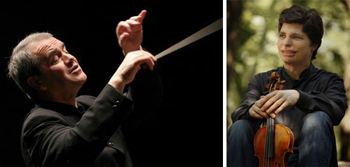by Daniel Hathaway

Then in 2010, his surprise debut with the New York Philharmonic in Vail, Colorado, involved replacing Nikolai Znaider in the Mendelssohn concerto on three days’ warning. (Hadelich was at the airport about to board a plane to Italy when he got the call).
His appearance with The Cleveland Orchestra on Saturday evening for the opening concert of its Blossom season may have been even more hastily arranged, as Renaud Capuçon’s illness and his replacement by Hadelich had to be announced in an insert to the program. And in the way history sometimes crazily repeats itself, guest conductor Hans Graf had earlier agreed to take over for Jaap van Zweden with only a few more days than Hadelich had to check his scores and pack his bags.
Incidents like that must be ulcer-inducing for management, but the enormous crowd in the pavilion and on the lawn couldn’t have been more pleased with Saturday evening’s program of Tchaikovsky, Sibelius and Dvořák. Graf, Hadelich and the Orchestra were in top form, the weather was perfect, and there were fireworks to be had both onstage and in the sky.
Sibelius’s violin concerto is a thorny piece for most violinists to tackle, especially on this occasion on what must have been minimal rehearsal. After a fleeting moment of unsettled intonation at the beginning, Augustin Hadelich took firm hold of the piece and delivered a performance that would have been distinguished under any circumstances.
His tone was dark and gripping, and even though he seemed to be playing it a bit safe during some passages, he dispatched the concerto’s technical hurdles with verve, confidence, and a canny sense of Sibelius’s style, which Graf and the orchestra mirrored sensitively. The audience was long and lavish in its ovation, and Hadelich gave them a luscious performance of Paganini’s ninth caprice as dessert.
The concert opened with a sumptuous performance of Tchaikovsky’s Capriccio Italien, yet another nineteenth-century Northern visitor’s tribute to the sunny South. In this case, after a golden introduction by the brass based on a bugle call, brooding Russian emotions alternate with rhapsodies on cheerful, sentimental tunes, usually doubled in thirds and played ebulliently by oboes and trumpets.
Dvořák’s “New World” Symphony, perhaps performed too often for its own good, received a delightfully fresh-sounding reading by Hans Graf and the Orchestra on Saturday evening. Graf is an efficient conductor but one who knows how to tease out alluring details in the score, aided by an orchestra who are able to approach an old warhorse as if for the first time. The brass were particularly impressive in their warm, blended sound, and assistant principal oboe Jeffrey Rathbun found lovely new things to say in the famous slow movement English horn solo.
It all added up to a festive summer evening of music in a beautiful setting. The fireworks were great, too.
Published on ClevelandClassical.com July 8, 2014.
Click here for a printable copy of this article.



